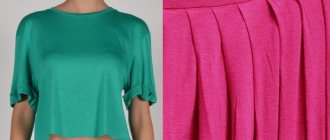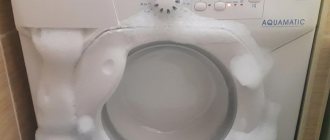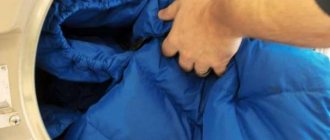The multilayer perforated structure of the fabric retains its functions for a long time if you select and use the detergent correctly.
For this purpose, special gels are purchased for washing membrane clothing, which delicately and thoroughly clean the fabric.
Why you can’t wash membrane clothes with regular powder
If you want to preserve the properties of membrane fabric for a long time, when washing it, you should absolutely not use ordinary washing powders. These products have a crystalline structure that does not completely dissolve in water. The smallest particles act as an abrasive. In addition, they penetrate and reliably clog all the pores in the membrane - after which no rinsing can remove them from there.
If the pores of the membrane are clogged, then it stops transmitting excess heat. The air does not circulate, moisture condenses under the fabric, the microclimate is disrupted, and, as a result, the body does not breathe.
But that's not all the negative effects of crystalline detergents. The chemical composition of such powders is not suitable for washing membranes - the aggressive chemical environment dissolves the fibers, compromising their integrity. Therefore, pre-dissolving it in water and washing it in a settled solution will not help.
The chemical composition of the powders includes anionic surfactants, various stabilizers, optical brighteners, which are very unsafe not only for membrane things, but also for human health, as well as various amine salts, catalysts and additives.
Not all of these elements are suitable for washing products with climate membranes. It is better to choose washing gels - they are optimal for the membrane: they do not worsen its properties and do not deform the product.
Prohibited means
Powdered detergents are not suitable for washing membrane clothing.
Washing powder for the membrane will not work, as will any bleaches, all-purpose shampoos and conditioners. Conventional products quickly wash away the protective layer of membrane clothing, negating the protection against dirt, moisture and wind. As a result, the clothes have to be replaced with new ones. To prevent such consequences and extend the service life of the material, you should avoid the following types of detergents:
- With enzymes. Enzymes mistake the membrane coating for dirt and remove it.
- With chlorine. This substance causes loss of protection against moisture penetration. In rain and snow, a jacket, cardigan or other item will begin to get wet very quickly.
- With bleach. Such a product will not only damage the membrane, but will also remove the original dye from the fabric, leaving streaks or a light stain.
- Conditioners, conditioners. Any additional action of the product may lead to loss of membrane properties.
- Powders for membrane clothing. Even if the product is marked that it is intended for membranes, you should not believe the advertising ploy. Powder particles clog the pores of the fabric, worsening its properties.
- Preparations with abrasive particles. The small particles, which are designed to remove stains from durable fabrics, will wear away the membrane and can even damage the fabric to the point that it becomes scuffed.
The membrane product must be special and marked accordingly on the packaging. Folk remedies, home recipes, and universal powders will not work.
Additional information: In special conditions, it is allowed to occasionally use only laundry soap without additives, but this cleaning option is not optimal. Although soap will not damage the membrane, it will clog the breathing pores of a jacket or tracksuit.
Maintenance of membrane products
For membrane fabric, except for powders, the following traditional techniques are strictly forbidden:
- Forget boiling your workout clothes. Synthetic material is not suitable for this. The membranes will stick together, and the product will only be suitable for the garden, cottage or garage. To completely eliminate the risk of membrane damage, you can only use warm water, no higher than 40 °C.
- Machine washable, but only on delicate cycle. Mechanical impact must be reduced as much as possible. Such clothes require space and a lot of water.
- You cannot wring out the clothes by twisting them. Even slight twisting will lead to deformation and rupture of membrane fibers. If, in order to speed up drying, you decide to remove excess water from the membrane overalls using a washing machine, then do it at minimum speed, do not set it above 400 rpm.
- Dry only naturally - no radiators, air heaters or other heating devices. This rule logically follows from the ban on washing membranes at high temperatures, but it is still necessary to repeat it, since this procedure can occur on autopilot.
- Don't wash very often. If you have stained the cuff of your jacket, remove the dirt with a soft brush and a small amount of cleaning product. This will save your time and eliminate the need to treat outerwear with water-repellent impregnations. During the operation of membrane jackets, the moisture-resistant layer is damaged over time. This is easy to determine - water begins to be absorbed into the fabric, rather than collecting on it in small balls.
- Do not use traditional conditioners, rinse aids and other impregnations for regular laundry - only special products for membrane clothing. Then you will be sure that your items will last at least 3-5 seasons.
Chemical solutions are inherently aggressive, and this is unacceptable for temperature-regulating products - a gentle environment is required. Therefore, we will consider the popular products offered by industrial manufacturers.
Care after washing
Manufacturers of membrane clothing warn that over time, the upper impregnation of the product may begin to wear out. How to find out about this? You will feel that in these places the clothes have become wet or are easily blown away by the wind. Therefore, it is important to purchase special products for the care of membrane clothing. They are produced by the same manufacturers as special detergents.
Membrane care devices allow you to restore the top impregnation layer of the membrane, extending its service life. There are two types:
- Aerosol. Apply to dry areas of clothing.
- Liquid. Added to water when rinsing the product.
Do not abuse such means. There is no need to apply them after every wash, only as needed. Then membrane clothing will serve for many years and provide comfort in all weather conditions.
Popular membrane washing products
Today on the market there is a huge number of special washing products that were specially developed by manufacturers for maximum protection and maintenance of all-season membrane laundry. Since the range of these products is very large, we will consider and compare the most popular of them - most of them are water-based liquids and gels.
Daily wash – Laska
Washing gel “Laska Active & Fresh” is optimal for the membrane. Sold in liter plastic bottles with a convenient measuring cap. The chemical composition is designed for frequent washing of sports membrane clothing. It contains enzymes, phosphonates and liquid soap, as well as small amounts of preservatives and foam stabilizers. Can be used in both hand and machine wash. The optimum ratio of price and quality.
The weasel can “refresh” your clothes, but it doesn’t cope well with serious stains—it definitely can’t handle grass stains. After washing, things retain a specific aroma. It is quite pleasant, but somewhat intrusive, and therefore “Laska” should not be abused. It is not recommended for allergy sufferers.
Nordland – membrane balm
Nordland laundry detergent from German manufacturers is suitable for lovers of Decathlon and other outdoor activities. A plastic bottle, a convenient measuring cap, and a well-thought-out neck shape will prevent the product from spilling past.
The balm does not contain dyes and all kinds of fragrances - only soap, active and passive anionic components and enzymes. Does not irritate the skin. However, the product has a pungent odor.
The product preserves the structure and shape of clothing and does not damage the fibers of the membrane fabric. It copes well with heavy dirt and does not spoil the color of the product. Eliminates sweat odor rather than just covering it up. The aroma of the balm is sharp, but pleasant, disappears in two to three days - the smell of sweat does not appear.
When washing heavily soiled jackets, manufacturers recommend soaking for 30–40 minutes. In particularly difficult cases, additionally wash dirty areas with the same product.
Universal product Grangers 2in1 Wash & Repel
Liquid from UK manufacturers. The price is steep, but it's worth it if your time is valuable to you. Chemical composition: nonionic surfactants, fluorocarbon polymers and preservative.
Does not disrupt the functionality of the membrane, renews and restores the protective water-repellent barrier. Does not affect durability and does not deform clothing.
Deep wash shampoo Salton Sport
Packaging of Salton shampoo 250 ml. This product differs from others - increased foaming, which is effective in combating severe stains. Gently acts on membrane tissue, does not clog or injure it.
The composition includes: amphoteric, nonionic and amphoteric surfactants, dispersion polymer and sodium hydroxide. These components ensure deep penetration of the product and guarantee the removal of even tough stains.
Due to the fact that Salton Sport foams strongly, at least 3-4 rinses are required to completely remove the product. Neglect of this rule will lead to divorce.
Woly Sport – product for outerwear
Woly Sport is the best detergent for washing outer membrane clothing. Gentle care - the material does not deform, the membrane is not damaged, the pores are cleaned, the fabric remains soft and elastic, the color does not deteriorate. The gel foams easily, the consumption is economical and 260 ml of product is enough to wash the outerwear of the whole family. The smell is mild, and therefore allergy sufferers tolerate it satisfactorily - it dissipates quickly.
Despite the fact that the product foams strongly, there are no streaks on clothes - this is after 1-2 rinses. The membrane jacket retains its presentation for more than three seasons of wear.
Nikwax Tech Wash – liquid soap for membranes
This liquid soap is unique in its own way. It is absolutely non-toxic and does not have a pungent odor, which is greatly appreciated by asthmatics.
If you notice that the membrane of your overalls does not cope with its main function, then Nikwax Tech Wash liquid soap can solve this problem. If the loss of properties is caused by clogging of the pores of the climatic fabric with dirt, then the deep penetration of this composition, based on a soft alkaline environment, will carefully restore your favorite item. In addition, it contains a component that will refresh the water-repellent barrier.
However, do not expect a strong effect on cleaning the outer surface of the jacket - it cannot handle complex stains; additional measures are required here: soaking and local cleaning with a brush. In addition to this minus, it can be noted that this product is not cheap.
Which product to choose - comparison
When choosing a particular product, consider the following factors:
- Consider what items you are purchasing detergent for. Will it be plain or colored fabrics, is it necessary to contain aggressive substances in the product or not.
- How often do you expect to wash the membrane - children's jackets and pants require more frequent care. Moreover, in this case, the contamination will be stronger, so opt for stronger products with deep penetration into the tissue.
- If you lead an active lifestyle or sweat excessively, then select formulations for frequent washing. In this case, buy samples with surface action and economical consumption.
- Most formulations have a pungent odor, which is contraindicated for allergy sufferers and people with respiratory problems. Therefore, opt for formulations with a minimal chemical composition, giving preference to organic substances.
- When traveling, carry universal two-component products with you. Then your clothes will be clean and resistant to wind and rain, and you can spend your free time on your favorite activities.
Price is also an important selection factor. The table shows the prices and main properties of popular products.
| Brand, country of origin | Detergent type | Volume (ml) | Estimated cost (RUB) | Note |
| Laska Active&Fresh, Russia | Gel | 1000 | 300 | A universal product with a pungent odor, enough for 10–12 washes |
| Woly Sport, Germany | Liquid gel | 260 | 500 | For maintenance of outerwear, economical consumption - enough for 8-10 items |
| Nordland, Germany | Balm | 1500 | 700 | Organic components – biodegradable, non-allergenic |
| Salton Sport, Russia | Shampoo | 250 | 250–300 | Foams a lot, gets rid of stains, requires 3-4 rinses |
| Grangers 2in1 Wash & Repel, UK | Liquid 2 in 1 (washing + impregnation) | 300 | 1100–1200 | Cleans the membrane and restores the water-repellent layer |
| Nikwax Tech Wash, UK | Liquid soap | 300 | 600 | Suitable for washing small items, rinses well, lasts for 20–25 washes |
Recommendations for machine washing
- Since membrane products do not tolerate mechanical stress, wash only in the delicate cycle. Load the drum not to capacity - one jacket or one overall - this will help reduce the risk of damage to fragile membrane fibers and protect them from micro-tears.
- Before loading, check the pockets for foreign objects and small debris. Coins, for example, can not only damage the product, but also ruin the washing machine by cutting through the rubber casing. Fasten all pockets with zippers or buttons, and turn the jacket itself with the lining facing out. Unfasten the fur linings and wash them separately.
- Place the washing machine in the delicate wash mode and add shampoo or gel in the amount recommended by the manufacturer into the detergent compartment. In some cases, membrane detergent can be added directly to the drum. Wash at a temperature no higher than 40 °C, if washed every day - then at 30 °C.
- Many membrane products have increased foaming, so rinse your laundry at least 2-3 times - this will help you get rid of stains on the fabric and also reduce the strong smell of the detergent.
- Do not use a machine spin - this is acceptable, but not recommended. Wring gently, without twisting, so as not to damage the fabric. If you use a machine spin, then set the minimum speed: 400 rpm.
- After washing, dry the items naturally. It is prohibited to use heating devices - there is a high risk of damage to the membrane function.
How and with what to wash membrane clothes
How to wash properly
Membrane fabric also repels dirt, so you rarely have to wash it. Frequent washing is undesirable because it will very quickly remove the top coating of the clothing, which is responsible for the water-repellent functions. Before washing be sure to:
- Fasten all zippers and buttons.
- Unfasten the fur parts and removable parts of the decor.
- If possible, place fur that cannot be removed in a waterproof plastic bag.
- If you are worried about the fittings, cover them with several layers of tape.
- Take things out of your pockets.
- Remove any existing dirt with a napkin.
- Check the label for any special care requirements.
For maximum safety, manufacturers indicate the acceptable type of washing - hand-washing. In this case, long-term soaking is not required, since it has a negative effect on the material.
It is recommended to wash each item of clothing separately from other items
Hand wash steps:
- Fill a container with warm water (temperature up to 40 degrees).
- Add powder or liquid for washing membrane fabrics (calculate the amount according to the instructions), stir.
- Place the product in water, after it is completely wet, start washing.
- Do not rub or twist the material. Make all movements carefully and gently.
- To remove tough stains, scrub lightly with a soft-bristled foam brush.
- Rinse clothes thoroughly under running cool water.
- Hang the item over the bathtub until excess moisture has completely drained away.
If you exclusively use a washing machine, follow these guidelines when washing membrane clothing:
- choose a delicate washing mode;
- Pre-clean the compartment from any remaining washing powder;
- place a single item in the drum;
- set the temperature to 30–40 degrees;
- exclude automatic spin;
- use the “double rinse” function.
Clothes that are no longer dripping with water are hung on hangers in a vertical position or laid out horizontally. It is recommended to turn down jackets with thick filling inside out after washing.
Recommendations for hand washing
Hand washing is more flexible and less risky. The procedure for the latter is somewhat different from the machine one.
- For washing, take a basin of suitable size. Pour water and add the required amount of detergent, according to the seller's recommendations. Choose the temperature based on the degree of contamination of the membrane items - the dirtier they are, the higher the water temperature is needed, but not more than 40 °C.
- Unfasten the fur and also check the pockets for debris and zip them up.
- For the best effect, soak the laundry for 10–30 minutes (depending on the degree of contamination). Before soaking the overalls, carefully inspect them to remember the places where there are mud stains - then you will not miss them when washing.
- Wash gently, slightly wrinkling the laundry. If there are dirt stains on it, then treat these places with a soft brush or foam sponge with the same detergent (you can use laundry soap).
- Rinse the laundry - do this until all traces of detergent disappear. It may take 3 to 5 times.
- Gently, without twisting, squeeze out excess moisture and hang the washed clothes to dry away from heating appliances.
If you don’t have special chemicals on hand, you can use laundry soap. Grate it on a fine grater and dissolve it in water - the latter should not foam much. Remember alkali is harmful to membrane linen; use only weak solutions.
The main principle when washing climate fabrics is do not harm the membrane. Use only special products or weak alkaline solutions prepared independently from laundry or baby soap.










